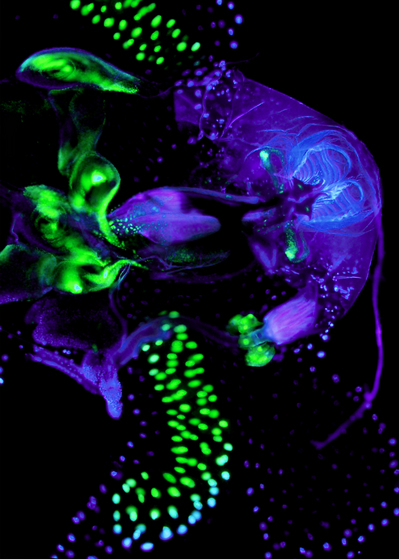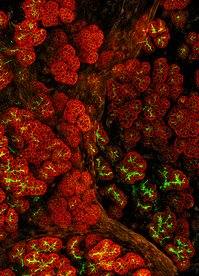Bio-Artography booth at Art Fair merges science and art

“Flychedelic” by graduate student Andrea Ramos. This image shows a developing larva of the fruit fly drosophila melanogaster.
The Bio-Artography booth is # 155 located on the corner of East University and Willard at the South University Art Fair.
Deborah Gumucio, professor of cell and developmental biology and computations medicine and bioinformatics, uses her creativity to digitally clean up most of the images, sometimes changing their contrast, color, or composition to prepare them for Art Fair shoppers. A panel of professional artists and people associated with art, design, and architecture schools at U-M choose around 20 new images (from the 60 to 100 that are submitted each year) to feature in the booth, and they also bring back a handful of old favorites from past years.
“Mostly the images come from biological fields, but we also have bioengineering images that show inorganic things, like the scaffolds and structures that they make. We get images from chemistry, which are crystalline. For the most part, it is a whole ton of biological tissues of various animals,” Gumucio explains. New this year, “we got images of bacteria and viruses for the first time.”
All the money raised funds travel grants to send students and postgraduates to conferences and meetings. They give out the grant money in $500 chunks to applicants by lottery.

“Moon Over My Pancreas” by graduate student Brian Larsen. This image depicts part of a developing mouse pancreas.
A group of faculty and students from U-M sciences is on hand at the Art Fair booth to “field the questions and talk about the science,” Gumucio explains.
The vast majority of biological tissues on display do not come from humans. Gumucio says there are human use issues that restrict that. However, certain cell lines that were sanctioned by the Bush administration before legislation against the use of embryonic stem cells appear at the booth. “There are certain established cell lines that are human lines including the famous HeLa line, which came from Henrietta Lax. It was the first cell line ever to be maintained and kept in a laboratory, and they were used for vaccine development and all kinds of things,” she explains.
More on the fair
Additional Ann Arbor Art Fair stories:
The artworks toe the line between scientific authority and artistic creativity. Gumucio manipulates many of the images on the computer, applies filters, cleans images up when their resolution is low, changes hues and colors, adds things like dry brush or under painting in Photoshop, and plays around with the composition. Other images are unchanged or the scientist who takes the image is the one who adds artistic elements.
“It’s blurring the line between art and science,” Gumucio says.
She also points out that “scientific research relies on imagery,” and scientists frequently manipulate tissues to better study them and see their inner workings. For example, “all tissues are transparent to begin with. To get the colors you see in scientific images we have to apply stains or antibodies” that alter the look, she explains. “We couldn’t really study science they way we do without some level of creativity” coming into play, she says.
One of Gumucio’s favorite works is called “Van Gogh’s Skin,” a picture of basel cell carcinoma. The image’s creator Mark Hutchin (House Officer, Dermatology) added a yellow swirl to mimic the swirls in Van Gogh’s painting “Starry Night.”
She also reports that images of human embryonic stem cells are particularly popular with visitors at the Art Fair booth. And another favorite pictures the hippocampus of the brain, “the seed of memory,” which appears like a blue and purple seahorse (“hippocampus” is the Greek word for “seahorse).
You can view a series of quilts inspired by the Bio-Artography project at the Biomedical Science Research Building (109 Zina Pitcher Place) at the U of M. Artists from Washington DC group Fiber Artists at Loose Ends visited the Art Fair booth and got the idea to travel quilts inspired by the original images at hospitals across the U.S.
Visit the Bio-Artography booth on East University Avenue, in the South University Art Fair. View and purchase Bio-Artography artworks anytime of year on their website, bioartography.myshopify.com


Comments
Jennifer Eberbach
Wed, Jul 20, 2011 : 8:02 p.m.
It's booth # 155 located on the corner of East University and Willard at the South University Art Fair.
John of Saline
Thu, Jul 21, 2011 : 3:47 p.m.
It was cool. Got a picture.
John of Saline
Wed, Jul 20, 2011 : 8:57 p.m.
Thanks; I'll have a look.
VamosAzul
Wed, Jul 20, 2011 : 5:40 p.m.
Where is the booth is located within the fair? Any street names or intersections to help me find it? I'd love to check this stuff out.